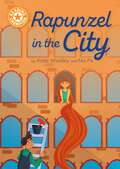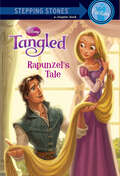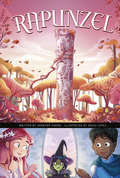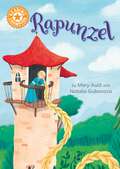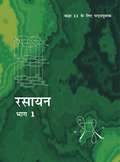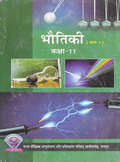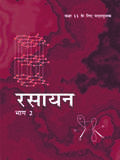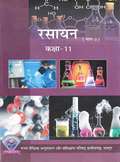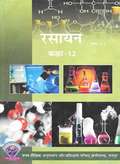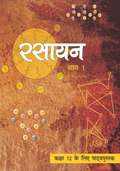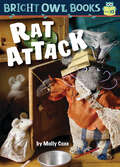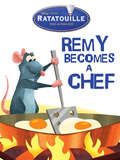- Table View
- List View
Rapunzel in the City: Independent Reading Orange 6 (Reading Champion #1614)
by Katie WoolleyThis story is part of Reading Champion, a series carefully linked to book bands to encourage independent reading skills, developed with Dr Sue Bodman and Glen Franklin of UCL Institute of Education (IOE)In this retelling of the Rapunzel fairy tale, Rapunzel is reimangined in a city and is locked up by a witch in a tower block. One day, a window cleaner with a ladder comes to help rescue Rapunzel ... Fantastic, original stories are accompanied by engaging artwork and a reading activity. Each book has been carefully graded so that it can be matched to a child's reading ability, encouraging reading for pleasure. Perfect for 5-7 year olds or those reading book band purple.
Rapunzel's Tale (Disney Tangled)
by Barbara BazalduaThe swashbuckling, computer-animated comedy—Disney Tangled—arrives in theaters Holiday 2010. This exciting chapter book retells the whole story from Rapunzel's point of view.
Rapunzel: A Discover Graphics Fairy Tale (Discover Graphics: Fairy Tales)
by Jennifer FandelRevisit the tale of Rapunzel. The princess in the tower longs for friends--and she finds one, in the shape of a curious prince. Will the princess get her happily ever after, or grow old at the top of the tower?
Rapunzel: Independent Reading Orange 6 (Reading Champion #516)
by Mary AuldThis story is part of Reading Champion, a series carefully linked to book bands to encourage independent reading skills, developed with Dr Sue Bodman and Glen Franklin of UCL Institute of Education (IOE)Reading Champion offers independent reading books for children to practise and reinforce their developing reading skills.Fantastic stories are accompanied by engaging artwork and a reading activity. Each book has been carefully graded so that it can be matched to a child's reading ability, encouraging reading for pleasure. This retelling of the original fairytale is suitable for children aged 5-7, or those reading at book band Orange.
Rarang Dhang SYBA Third Semester - SPPU: रारंग ढांग एस.वाय.बी.ए. सेमिस्टर ३ - सावित्रीबाई फुले पुणे यूनिवर्सिटी
by Prabhakar Pendharkarप्रभाकर पेंढारकर यांचं हे अतिशय गाजलेलं पुस्तक. पेंढारकर यांनी अत्यंत वेगळा विषय रोचक पद्धतीनं हाताळला आहे. हिमालयात रस्ते बांधणारी बॉर्डर रोड ऑर्गनायझेशन, सैन्यदलातील इंजिनिअरिंग विभाग, बॉर्डर रोडचा प्रमुख, टास्क फोर्स कमांडर्स या वेगळ्याच जगाबरोबर माणसांना आणि यांत्रांनाही थकविणारी हिमालयाची उंची, विरळ ऑक्सिजन, लहरी हवा, विलक्षण थंडी, दरडी कोसळणं, रक्त गोठवणारा बर्फ अशा बेभरवशी निसर्गाचं दर्शन घडतं. दुसरीकडे वेगवेगळ्या स्वभावाची माणसंही भेटतात. माणसं आणि निसर्ग यांचं नातं गुंफणारं, संघर्ष दाखविणारं वेगळं कथानक आकाराला येतं. पेंढारकरांची शैली चित्रमय आहे. त्यामुळे प्रसंग हुबेहूब डोळ्यासमोर उभे राहतात. वाचक त्यात गुंतून पडतो.
Rarity's Charity (My Little Pony Chapter Book Ser.)
by G. M. BerrowRarity is so stupendously excited to bond with her new apprentice, Charity, over fashion, glitz, and glamour. But when Charity dyes her mane and tail to look more like Rarity and begins copying her every move, Rarity realizes that this pony is a problem! How will Rarity show Charity that the best pony to be is yourself?Printed entirely in violet ink with brand-new illustrations throughout, young readers are sure to love this adaptation of My Little Pony: Rarity and the Curious Case of Charity!© 2019 Hasbro. All Rights Reserved.
Rasathanthram 1 class 10 - Malayalam Medium - SCERT Board: രസതന്ത്രം 1 മലയാളം മീഡിയം ക്ലാസ് 10 എസ്.ഇ.ആര്.ടി ബോര്ഡ്
by State Council of Educational Research and TrainingScientific activity, while enabling social progress, must also uphold eco-friendly values. This should happen at deeper levels of any science enquiry and activity. The text has tried to incorporate such ideologies to the possible extent and to discuss emerging areas like Green Chemistry. The text provides opportunities for student's active participation in the classrooms. We have tried to organise these activities giving due emphasis to the level of your competence through investigative learning. The initial units focus on explaining peculiarities of elements related to their electronic configuration, identifying the relationship between mass of substances and their number of molecules and also identifying the significance of mole concept in chemistry. Following this, discussions on the rate of reactions and equilibrium and chemical reactivity of metals and their stages of production are made. Some basic concepts in Organic Chemistry are discussed in this textbook. The educational portal ‘Samagra’ and the QR Code incorporated textbook make the classroom learning process effortless and stimulating. National Skills Qualification Framework (NSQF), Disaster management techniques relevant to contemporary issues and the ICT possibilities are considered in this textbook.
Rasathanthram Bhagam 1 class 9 - Kerala Board: രസതന്ത്രം ഭാഗം 1 സ്റ്റാന്ഡേര്ഡ് IX
by State Council of Educational Research and Trainingപരീക്ഷണത്തിലൂടെയും നിരീക്ഷണത്തിലൂടെയും വിശകലനത്തിലൂടെയും മനുഷ്യൻ കൈവരിച്ച അറിവാണ് ശാസ്ത്രം. നാം ആർജിച്ച എല്ലാ നേട്ടങ്ങൾക്കും കാരണം ശാസ്ത്രരംഗത്തുണ്ടായ വളർച്ചയാണ്. കൂടുതൽ പുരോഗതിയും നേട്ടങ്ങളും ലക്ഷ്യമിടുന്ന എല്ലാവർക്കും ശാസ്ത്രപഠനം ഗൗരവമായ വിഷയമാണ്. അതിനു
Rasathanthram Bhagam 2 class 9 - Kerala Board: രസതന്ത്രം ഭാഗം 2 സ്റ്റാന്ഡേര്ഡ് IX
by State Council of Educational Research and Trainingപരീക്ഷണത്തിലൂടെയും നിരീക്ഷണത്തിലൂടെയും വിശകലനത്തിലൂടെയും മനുഷ്യൻ കൈവരിച്ച അറിവാണ് ശാസ്ത്രം. നാം ആർജിച്ച എല്ലാ നേട്ടങ്ങൾക്കും കാരണം ശാസ്ത്രരംഗത്തുണ്ടായ വളർച്ചയാണ്. കൂടുതൽ പുരോഗതിയും നേട്ടങ്ങളും ലക്ഷ്യമിടുന്ന എല്ലാവർക്കും ശാസ്ത്രപഠനം ഗൗരവമായ വിഷയമാണ്. അതിനു
Rasayan Bhag 1 class 11 - NCERT: रसायन भाग 1 कक्षा 11 - एनसीईआरटी
by Rashtriy Shaikshik Anusandhan Aur Prashikshan Parishadरसायन भाग 1 11वीं कक्षा का राष्ट्रीय शैक्षिक अनुसंधान और प्रशिक्षण परिषद् ने पुस्तक हिंदी भाषा में प्रकाशित किया गया है। इस पाठ्यपुस्तक के सात अध्याय एकक हैं। विभिन्न एककों के शीर्षक देखने से लगता है कि विषयवस्तु भौतिक, अकार्बनिक एवं कार्बनिक रसायन में विभाजित है परंतु पाठक यह पाएँगे कि इन उपविषयों में जहाँ तक संभव हो सका, परस्पर संबंध स्थापित किया गया है जिससे विषय की एकीकृत पहुँच बनी रहे। वास्तव में विषय को रसायन के नियमों एवं सिद्धांतों के चारों ओर संघटित किया गया है। मूल-पाठ को परिवेश से उदाहरण देते हुए भली प्रकार समझाया गया है जिससे अवधारणा के गुणात्मक और मात्रात्मक पक्षों को समझना सुसाध्य तथा आसान हो जाएगा।
Rasayan Bhag 1 class 11 - S.C.E.R.T Raipur - Chhattisgarh Board: रसायन (भाग 1) कक्षा 11 - एस.सी.ई.आर.टी. रायपुर - छत्तीसगढ़ बोर्ड
by Raipur C. G. Rajya Shaikshik Anusandhan Aur Prashikshan Parishadरसायन (भाग-1) कक्षा 11 वीं का राज्य शैक्षिक अनुसंधान और प्रशिक्षण परिषद् छत्तीसगढ़ रायपुर ने पुस्तक हिंदी भाषा में प्रकाशित किया गया है, इस पुस्तक में रसायन विज्ञान की मूल अवधारणाओं, परमाणु की संरचना, गुणधर्मों में आवर्तिता, रासायनिक आबंधन तथा विभिन्न प्रकार की अभिक्रियाओं से अवगत किया गया है। इस पाठ्यपुस्तक में सात अध्यायों का विवरण किया गया है।
Rasayan Bhag 2 class 11 - NCERT: रसायन भाग 2 कक्षा 11 - एनसीईआरटी
by Rashtriy Shaikshik Anusandhan Aur Prashikshan Parishadरसायन भाग 2 11वीं कक्षा का राष्ट्रीय शैक्षिक अनुसंधान और प्रशिक्षण परिषद् ने पुस्तक हिंदी भाषा में प्रकाशित किया गया है। इस पाठ्यपुस्तक के छह अध्याय एकक हैं। विभिन्न एककों के शीर्षक देखने से लगता है कि विषयवस्तु भौतिक, अकार्बनिक एवं कार्बनिक रसायन में विभाजित है परंतु पाठक यह पाएँगे कि इन उपविषयों में जहाँ तक संभव हो सका, परस्पर संबंध स्थापित किया गया है जिससे विषय की एकीकृत पहुँच बनी रहे। वास्तव में विषय को रसायन के नियमों एवं सिद्धांतों के चारों ओर संघटित किया गया है। मूल-पाठ को परिवेश से उदाहरण देते हुए भली प्रकार समझाया गया है जिससे अवधारणा के गुणात्मक और मात्रात्मक पक्षों को समझना सुसाध्य तथा आसान हो जाएगा।
Rasayan Bhag 2 class 11 - S.C.E.R.T Raipur - Chhattisgarh Board: रसायन भाग 2 कक्षा 11 - एस.सी.ई.आर.टी. रायपुर - छत्तीसगढ़ बोर्ड
by Rajya Shaikshik Anusandhan Aur Prashikshan Parishad Raipur C.G.रसायन (भाग-2) कक्षा-11वीं का राज्य शैक्षिक अनुसंधान और प्रशिक्षण परिषद् छत्तीसगढ़ रायपुर ने पुस्तक हिंदी भाषा में प्रकाशित किया गया है, इस पाठपुस्तक में सात अध्याय दिये गये है, जिसमे हर अध्याय के विवरण कि व्याख्या कि गई है ।
Rasayan Bhag 2 class 12 - NCERT: रसायन भाग 2 कक्षा 12 - एनसीईआरटी
by Rashtriy Shaikshik Anusandhan Aur Prashikshan Parishadरसायन भाग 2 12 वीं कक्षा का राष्ट्रीय शैक्षिक अनुसंधान और प्रशिक्षण परिषद् ने पुस्तक हिंदी भाषा में प्रकाशित किया गया है। इस पाठ्यपुस्तक के नौं अध्याय एकक हैं। विभिन्न एककों के शीर्षक देखने से लगता है कि विषयवस्तु भौतिक, अकार्बनिक एवं कार्बनिक रसायन में विभाजित है परंतु पाठक यह पाएँगे कि इन उपविषयों में जहाँ तक संभव हो सका, परस्पर संबंध स्थापित किया गया है जिससे विषय की एकीकृत पहुँच बनी रहे। वास्तव में विषय को रसायन के नियमों एवं सिद्धांतों के चारों ओर संघटित किया गया है। विद्यार्थी इन नियमों एवं सिद्धांतों पर प्रवीणता प्राप्त कर लेने के पश्चात प्रागुक्ति करने की स्थिति में पहुँच जाएंगे। ऐतिहासिक विकास और जीवन में उपयोग बताते हुए, विषय में उत्सुकता जाग्रत रखने का प्रयास किया गया है। मूल-पाठ को परिवेश से उदाहरण देते हुए भली प्रकार समझाया गया है जिससे अवधारणा के गुणात्मक और मात्रात्मक पक्षों को समझना सुसाध्य तथा आसान हो जाएगा।
Rasayan Bhag 2 class 12 - S.C.E.R.T Raipur - Chhattisgarh Board: रसायन (भाग 2) कक्षा 12 - एस.सी.ई.आर.टी. रायपुर - छत्तीसगढ़ बोर्ड
by Raipur C. G. Rajya Shaikshik Anusandhan Aur Prashikshan Parishadरसायन (भाग 2) कक्षा 12 वीं का राज्य शैक्षिक अनुसंधान और प्रशिक्षण परिषद् छत्तीसगढ़ रायपुर ने पुस्तक हिंदी भाषा में प्रकाशित किया गया है, इस पुस्तक में रसायन विज्ञान की मूल अवधारणाओं, परमाणु की संरचना, गुणधर्मों में आवर्तिता, रासायनिक आबंधन तथा विभिन्न प्रकार की अभिक्रियाओं से अवगत किया गया है। इस पाठ्यपुस्तक में सात अध्यायों का विवरण किया गया है। उसके साथ साथ कुछ अभ्यासार्थ प्रश्नों के उत्तर और तकनीकी-शब्दसूची भी पाठ्यपुस्तक दि गई है।
Rasayan Bhag-1 class 11 - NCERT - 23: रसायन भाग-१ ११वीं कक्षा - एनसीईआरटी - २३
by Rashtriy Shaikshik Anusandhan Aur Prashikshan Parishadरसायन भाग 1 11वीं कक्षा का राष्ट्रीय शैक्षिक अनुसंधान और प्रशिक्षण परिषद् ने पुस्तक हिंदी भाषा में प्रकाशित किया गया है। इस पाठ्यपुस्तक के सात अध्याय एकक हैं। विभिन्न एककों के शीर्षक देखने से लगता है कि विषयवस्तु भौतिक, अकार्बनिक एवं कार्बनिक रसायन में विभाजित है परंतु पाठक यह पाएँगे कि इन उपविषयों में जहाँ तक संभव हो सका, परस्पर संबंध स्थापित किया गया है जिससे विषय की एकीकृत पहुँच बनी रहे। वास्तव में विषय को रसायन के नियमों एवं सिद्धांतों के चारों ओर संघटित किया गया है। मूल-पाठ को परिवेश से उदाहरण देते हुए भली प्रकार समझाया गया है जिससे अवधारणा के गुणात्मक और मात्रात्मक पक्षों को समझना सुसाध्य तथा आसान हो जाएगा।
Rasayan Bhag-1 class 12 - NCERT - 23: रसायन भाग-१ १२ वीं कक्षा - एनसीईआरटी - २३
by Rashtriy Shaikshik Anusandhan Aur Prashikshan Parishadरसायन भाग-1 12 वीं कक्षा का राष्ट्रीय शैक्षिक अनुसंधान और प्रशिक्षण परिषद् ने पुस्तक हिंदी भाषा में प्रकाशित किया गया है। इस पाठ्यपुस्तक के पाँच अध्याय एकक हैं। विभिन्न एककों के शीर्षक देखने से लगता है कि विषयवस्तु भौतिक, अकार्बनिक एवं कार्बनिक रसायन में विभाजित है परंतु पाठक यह पाएँगे कि इन उपविषयों में जहाँ तक संभव हो सका, परस्पर संबंध स्थापित किया गया है जिससे विषय की एकीकृत पहुँच बनी रहे। वास्तव में विषय को रसायन के नियमों एवं सिद्धांतों के चारों ओर संघटित किया गया है। विद्यार्थी इन नियमों एवं सिद्धांतों पर प्रवीणता प्राप्त कर लेने के पश्चात प्रागुक्ति करने की स्थिति में पहुँच जाएंगे। ऐतिहासिक विकास और जीवन में उपयोग बताते हुए, विषय में उत्सुकता जाग्रत रखने का प्रयास किया गया है। मूल-पाठ को परिवेश से उदाहरण देते हुए भली प्रकार समझाया गया है जिससे अवधारणा के गुणात्मक और मात्रात्मक पक्षों को समझना सुसाध्य तथा आसान हो जाएगा।
Rasayan Bhag-2 class 11 - NCERT - 23: रसायन भाग-२ ११वीं कक्षा - एनसीईआरटी - २३
by Rashtriy Shaikshik Anusandhan Aur Prashikshan Parishadरसायन भाग-2 11वीं कक्षा का राष्ट्रीय शैक्षिक अनुसंधान और प्रशिक्षण परिषद् ने पुस्तक हिंदी भाषा में प्रकाशित किया गया है। इस पाठ्यपुस्तक के तीन अध्याय एकक हैं। विभिन्न एककों के शीर्षक देखने से लगता है कि विषयवस्तु भौतिक, अकार्बनिक एवं कार्बनिक रसायन में विभाजित है परंतु पाठक यह पाएँगे कि इन उपविषयों में जहाँ तक संभव हो सका, परस्पर संबंध स्थापित किया गया है जिससे विषय की एकीकृत पहुँच बनी रहे। वास्तव में विषय को रसायन के नियमों एवं सिद्धांतों के चारों ओर संघटित किया गया है। मूल-पाठ को परिवेश से उदाहरण देते हुए भली प्रकार समझाया गया है जिससे अवधारणा के गुणात्मक और मात्रात्मक पक्षों को समझना सुसाध्य तथा आसान हो जाएगा।
Rasayan Bhag-2 class 12 - NCERT - 23: रसायन भाग-२ १२ वीं कक्षा - एनसीईआरटी - २३
by Rashtriy Shaikshik Anusandhan Aur Prashikshan Parishadरसायन भाग 2 12 वीं कक्षा का राष्ट्रीय शैक्षिक अनुसंधान और प्रशिक्षण परिषद् ने पुस्तक हिंदी भाषा में प्रकाशित किया गया है। विभिन्न एककों के शीर्षक देखने से लगता है कि विषयवस्तु भौतिक, अकार्बनिक एवं कार्बनिक रसायन में विभाजित है परंतु पाठक यह पाएँगे कि इन उपविषयों में जहाँ तक संभव हो सका, परस्पर संबंध स्थापित किया गया है जिससे विषय की एकीकृत पहुँच बनी रहे। वास्तव में विषय को रसायन के नियमों एवं सिद्धांतों के चारों ओर संघटित किया गया है। विद्यार्थी इन नियमों एवं सिद्धांतों पर प्रवीणता प्राप्त कर लेने के पश्चात प्रागुक्ति करने की स्थिति में पहुँच जाएंगे। ऐतिहासिक विकास और जीवन में उपयोग बताते हुए, विषय में उत्सुकता जाग्रत रखने का प्रयास किया गया है। मूल-पाठ को परिवेश से उदाहरण देते हुए भली प्रकार समझाया गया है जिससे अवधारणा के गुणात्मक और मात्रात्मक पक्षों को समझना सुसाध्य तथा आसान हो जाएगा।
Rasayan Vignan Part-1 class 10 - GSTB Guidebook: રસાયણ વિજ્ઞાન ભાગ-૧ ધોરણ 10
by Navneet Education Limitedધોરણ 10 ની નવનીત છે જેમાં 5 પ્રકરણ આપેલ છે.
Rasgos: Las características animales
by Lisa RaoNIMAC-sourced textbook. ¡Descubre todas las diferencias que hay entre los anfibios, los reptiles, los mamíferos y más! Este libro analiza las criaturas más geniales y las características que las hacen especiales.
Rashtreeya Shikshana Neeti 2020: ರಾಷ್ಟ್ರೀಯ ಶಿಕ್ಷಣ ನೀತಿ 2020
by Manava Sampanmoola abhivr̥uddhi Sachivalayaಇದು ಜನರಲ್ ರಾಷ್ಟ್ರೀಯ ಶಿಕ್ಷಣ ನೀತಿ ಪಠ್ಯಪುಸ್ತಕ ಸಂಗ್ರಹಗಳನ್ನು ಈ ಪುಸ್ತಕವು ಒಳಗೊಂಡಿದೆ.
Rat Attack (Bright Owl Books)
by Molly CoxeDiscover Bright Owl Books! This super simple beginning readers series, created by best-selling Step into Reading author and illustrator Molly Coxe, features vowel sounds – basic building blocks of reading – and only around 100 words in each book. With a note to parents and teachers at the beginning and story starters at the end, these books give kids the perfect start on educational success.Gram is making jam. Can she keep it safe from all the rat attacks? This fun photographic easy-to-read story features the short &“a&” vowel sound.
Rat's Diner (Fountas & Pinnell Classroom, Guided Reading Kindergarten)
by Barbara Spurll James SpearsNIMAC-sourced textbook
Ratatouille: Remy Becomes a Chef
by VariousBon appétit! Remy the rat isn't your ordinary, garbage-eating rat. He has big dreams of becoming a chef! So when the old woman where he lives discovers him cooking in her kitchen late one night, she chases Remy and his family away! But Remy gets separated from them and finds himself blocks away from world-famous chef Gusteau's restaurant in Paris! There, he meets a garbage boy named Alfredo Linguini, Gusteau's son, who just wants to make his father proud. The problem is...Linguini can't cook! Can the unlikely pair team up and achieve their goals together? Don't miss this heartwarming tale as two friends work to make their dreams a reality!
